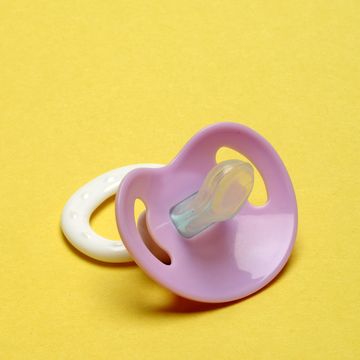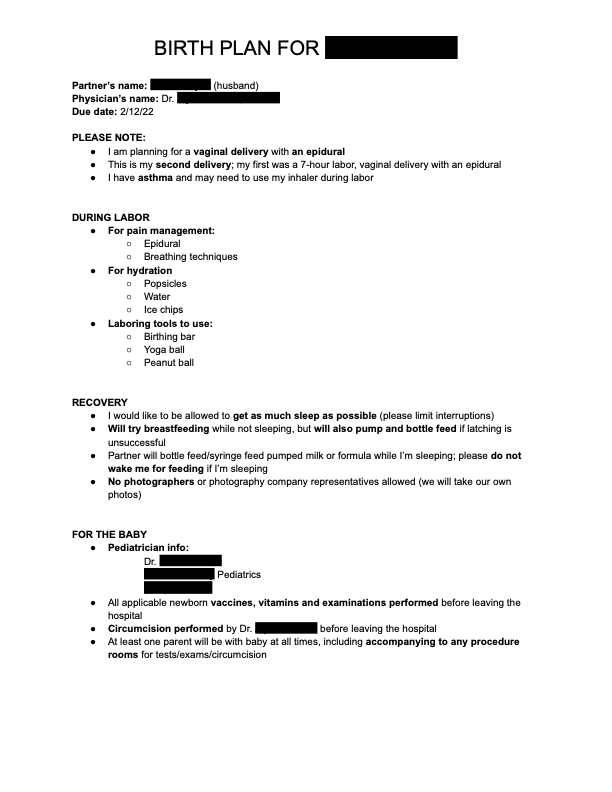What Natural Childbirth Is REALLY Like
One woman shares her experience of joy, pain, exhaustion, and more pain—and explains why she'd do it all over again.

When my editor first reached out to me with the idea of describing my drug-free childbirth, I was so close to turning her down. That’s because, honestly, it was painful beyond belief…but it’s also a decision I fully stand behind. And since women who opt out of meds are a minority, I didn’t want my story to scare away anyone who might be considering that route. I eventually changed my mind because I believe that one of the most powerful ways to prepare for labor is to hear other women’s stories and understand the full breadth of what might conceivably happen so that you can go into it with your eyes open.
Although I support every woman doing what’s best for her during labor, going au naturel was never much of a question for me. (After all, I use a neti pot instead of taking over-the-counter cold medicine and dab on lavender oil to relieve headaches rather than popping Advil.) I also wanted to be fully present for every moment of birth—the good and the bad.
So with that goal in mind, in my typical type-A approach, I began preparing soon after I found out I was pregnant. I did yoga daily, emphasizing labor-friendly poses like squats and cat-cow. My husband Sam and I went to childbirth classes, where we learned massage techniques and practiced pain coping strategies like meditation and vocalization. I made a mandala with a snapshot of my ultrasound to keep me centered during labor and religiously did kegels at every red light and commercial break.
After all that, I felt ready. I felt fearless. I felt up for the challenge. But oh my god, I had completely underestimated the tsunami in store for me.

Six Days After My Due Date, I Awoke at 3 a.m. I had a clenching sensation in my stomach, like someone wringing out a dishcloth. The contractions continued intermittently throughout the day, a sunny Sunday in August. Sam and I went hiking, watched the antique car parade in our little Vermont town, and snacked on paninis and milkshakes at the local malt shop.
I knew it would be smart to get some sleep, so I went to bed early. But as soon as I lay down, the contractions quickened and the pain intensified. I began to feel an inescapable sense of discomfort, the pain covering me like a heavy cloak that I couldn’t crawl out of.
Sam started timing the contractions and called our doula (basically, a birthing coach who focuses on the mother’s wellbeing). As soon as she arrived at our house, we headed to the birthing center. My doula warned me that the car ride would be hard and handed me a contraption made of two tennis balls taped together to put behind my lower back to relieve pressure, as well as a plastic comb, instructing me to press it into my palm as a way to redirect my mind away from the pain. She also had me tap rhythmically on the car dashboard, repeating “Oooh, oooh, aaaaaah” whenever a contraction came along.
After an endlessly long half hour (including getting stopped by the police for speeding—Sam was psyched to be able to triumphantly exclaim, “My wife is having a baby!”), we arrived.
Shortly After We Were Ushered Into Our Room, I Ceased Being a Person I transformed into a vessel of searing white-hot pain. This is kind of hard to explain, but I was beyond the point of feeling pain because it was so all-encompassing that I had become the pain.
When I think about the next 10 hours, a series of flashbacks reel through my mind like an unreal dream sequence: Lying on my side with a peanut-shaped exercise ball between my knees. Climbing into the whirlpool tub with Sam, who helped me into a squatting position for each contraction, then let me rest in his arms in between. Taking tiny sips of chilled ginger ale and cranberry juice so that I wouldn’t throw up. Standing excruciatingly still while the nurse measured the baby’s heartbeat, my hands on her warm, enviably relaxed shoulders. Sitting backwards on the toilet (a trick my midwife suggested to help speed things along), howling and pounding my hands against the cool tile wall as I went through transition (the most intense part of labor, when the baby descends into the pelvis).
My midwife smiling hugely, announcing that I was fully dilated and asking if I wanted to give birth in the water. Watching her pack up her tools to deliver a baby in the adjacent room after I failed to progress. Getting back on the hospital bed with my knees pulled up to my chest. Sam’s encouraging words that he could see more and more of the baby’s hair with every push. Screams echoing through my skull. Unbelievable fatigue mixed with buzzing adrenaline. Finally the baby’s body slipping out. Hearing Sam say, “It’s a boy!” and resting him on my chest. My midwife telling me I still had to deliver the placenta, though I was far beyond my last ounce of energy. Her alarmed voice when she realized it had broken into pieces and they couldn’t find it all. Sheets dripping with blood. Dozens of arms reaching into my body over and over again until after an eternity the specialist found the missing bits. Being wheeled into a dim, hushed room.
I Had Lost So Much Blood That I Could Barely Sit Up for Days I was on bed rest for weeks post-delivery, feeling as pale and spent as a shell. It was months before I was back to my normal level of activity, and truthfully, my fragmented body will probably never be completely the same. I was elated to be a mother and deeply in love with my little boy, Theo, but I also felt an undercurrent of disappointment. I’d worked so hard to get my mind and body ready, yet despite all my efforts, labor had been traumatic.
I wanted to find out whether my experience was typical for childbirth sans epidural and what, if anything, I should have done differently. So I called up Pam England, a childbirth mentor and instructor, “birth story listener,” former nurse-midwife, and author of the forthcoming book, An Ancient Map for Modern Birth . (She also wrote Birthing from Within , a guide for parents-to-be that became my bible in the months leading up to Theo’s birth.)
Unfortunately, she couldn’t weigh in on whether or not my agony was out of the ordinary. “Pain is so subjective and personal,” says England. “There isn’t a measuring stick we can use to compare different people’s experiences.” She did, however, point out that a multitude of factors come into play before and during labor that can influence your comfort. While some are within your control (e.g., studies show that women who exercise for 30 minutes a day during pregnancy have higher endorphin levels while in labor), others are harder to manage (think: your subconscious pain response conditioning).
A few of the contributors she talked about hit home for me. For one, Theo was posterior (positioned face-up in the uterus instead of face-down), which meant that before emerging, he had to spin around. (Just picture someone doing gymnastics inside your stomach.) The back of his head was pressed into the base of my spine, creating intense lower back cramps in addition to the regular aches of labor.
The length of childbirth was another trigger: 36 hours, including four grueling hours of pushing. “A long labor can increase stress hormones and throw pain into a tailspin,” says England.
RELATED: 8 Celebs Who Posed Nude While Pregnant—And Looked Gorgeous Doing It
Ironically, my confident mindset may also have done me in. While I certainly wasn’t expecting it to be like a relaxing day at the spa, I wasn’t worried. I have a naturally high pain threshold and was sure that I could handle whatever landed in my path because I had done all the right things to prepare. “It’s like school: There is this idea that if you study really hard and do the extra assignments, you’ll get an A and graduate with honors,” explains England. “For some people, that formula works; for others it doesn’t—they have a different kind of knowledge or creativity.” England adds that women who don’t carry high expectations about having an easy childbirth and who anticipate it to be incredibly painful may feel less agony simply because they aren’t shocked by it. (That’s also why moms tend to report having an easier go the second time around; even though birthing baby number two may be just as demanding, at least you know what you’re getting into.)
Fortunately, I’d had a lovely pregnancy. Aside from dwindling wardrobe options and substituting lemonade for red wine, having a bun in the oven barely affected my lifestyle. I hoped childbirth would follow the same smooth course, and my overall attitude was one of curious anticipation to find out what this wild process was all about. But England says that those of us who project that labor will be beautiful or calm or uncomfortable without being too painful may be caught off guard by the fierce reality and as a result, may have a more trying experience. “There is no such thing as a perfect birth that goes the way you wanted it to,” she says.
England explains that getting ready for labor is kind of like gearing up for a big hiking trip: “You pack a first aid kit and bear spray and come up with a plan for how to deal if it rains or snows," she says. "Then, you hope the weather will be gorgeous and everything will work out. Similarly, women need to prepare for the unexpected. Understand that there will almost always be a surprise and that whatever it is, you will find a way to negotiate it. That may require drugs or a cesarean or saying no when you are normally a polite person—and it always requires self love and humility.”
So, the Big Question If I were to have another kid, would I skip the epidural again? It may sound crazy, but yes. (I might, however, consider sterile water injections in my lower back, a chemical-free way to alleviate pain.) In the end, my labor was so arduous that drugs would have worn off anyway, and there quickly came a point where the pain didn’t even matter anymore because I was on another planet.
I've also continued thinking about England’s point about needing self-love to negotiate the unexpected. I was pretty down on myself when things weren’t turning out the way I’d wished. Then, I had a realization that brought me some peace: While it may not have been my dream birth scenario, if I hadn’t prepared as thoroughly as I had, I might not have had the physical strength and mental determination to make it through. But I never gave up, and I am tremendously proud of myself for that.
-- Molly Triffin is a freelance writer living in Vermont.
RELATED: This Is What Happens When You Give Birth on a Plane

Shop These Derm-Approved Stretch Mark Creams

11 Best Maternity Underwear Of 2024, Per Reviews

Try These 19 Best Sex Positions For Pregnancy

12 Best Pumping Bras Of 2024, Tested By Experts

Can You Get Pregnant From Anal Sex?

Why Do I Dream About Being Pregnant?

Who Needs An Iron Supplement? An RD Explains

These Gifts Will Make A Tired Pregnant Woman Happy

Kelsey Wells Pregnancy Strength And Mobility Sweat

These Stretches Are Essential During Pregnancy

23 Best Pregnancy Apps, According To Ob-Gyns

My Birth Story: Moms Share Their Birth Experiences
What to expect birth stories, jump to your week of pregnancy.
- For Birthworkers
- Carrie Murphy, Course Creator
- Course Access
I know this struggle firsthand—although I’m a writer and doula, I felt totally stuck on how to start writing my own birth story after having my son in 2018. I’m not really a perfectionist, but I wanted to get it right and produce something that felt authentic, true, and special, something both myself and my family could treasure well into the future. No pressure, right? :)
But seriously—there’s nothing wrong with wanting to know how to write your birth story! Birth matters, and so do our birth stories.
Here’s the process I followed, and my general advice to you on how to write your birth story.
1. Give Yourself Time
Although much of the advice here on the internet will tell you to write down your birth story ASAP after birth, I don’t necessarily agree. While that’s not bad advice, I don’t think it works for everyone. You’re exhausted, adjusting, recovering. Being reflective probably isn’t the first thing on your mind (or to do list!)
While it’s great to do the birth story soon after birth (or least make some notes), I’m here to tell you that it’s fine to take time, if you feel like you need time. It won’t lessen the quality of your story when you do write it.
2. Ground Yourself
Writing about such an important and life-changing event (no matter what happened during your birth) can be intense! For that reason, I recommend you ground yourself in some way before you write. Take some deep breaths, meditate a bit, listen to some favorite calming music, light a candle, do some stretches….be intentional in your setting of the space to remember and write.
3. Situate Your Birth Story In Time (And In Your Life)
4. ask others for help, 5. decide your format, 6. focus on details, the writing your birth story online course (just $39).
If you need a little help, I’ve created Writing Your Birth Story , an online course that (you guessed it!) helps parents write their birth stories. Writing Your Birth Story is for parents who want to have a memorable story for themselves or for a family keepsake, but who are feeling stuck, strapped for time, or just plain overwhelmed at the thought of sitting down to write such an important life event.
You don’t have to be a “good writer” to write a good birth story. The course will show you easy ways to tap into your own experience to produce a compelling, memorable story. You don’t have to have had a “good birth” to use this course, either. I’ve taken special care to include information on birth trauma and to make the overall course trauma-aware, keeping in mind that giving birth is not a positive experience for many people.
Writing Your Birth Story is inclusive of all birthing people, scenarios, situations, and choices, although it is geared towards people who had live births. My experience and perspective as a writer and doula informed every aspect of the course—it honors the beautiful multiplicity of birth itself while guiding students through their individual writing processes.
It’s $39. 15% of profits go to a BIPOC-led and centered person, group or organization.
However you approach your story, I have full confidence you’ll write a birth story that feels truthful and meaningful to you. Happy writing!
- Icon Link Plus Icon
optional screen reader
How to write a birth story.
by Christina Holt
Christina Holt
- Share on Flipboard Plus Icon
- Share on Pinterest Plus Icon
- Share on Facebook Plus Icon
- Share on Twitter Plus Icon

You don’t have to be a writer to write the story of the day your child entered the world. Follow these prompts to remember your special day and document it forever.

My baby is here! Now what?
The day you birthed your baby is playing on repeat in your head. The rush of adrenalin and emotions you’ve experienced during labor, birth and the first time you held your child are so powerful that you simply have to get it on paper. Guess what? You’re not alone. More and more women (and men) are turning to their computer, blog, a community website or a piece of paper and a pencil to tell the story of the day their child entered the world.
When to write a birth story
It’s best to write your birth story while the emotions are still fresh — as that is the time when you’ll capture most of the true feelings in your words. If you’re sleep deprived, unfocused or would rather take every moment to snuggle your baby, keep a notepad by your bed and write down little notes as you think of them. You can always go back to writing your birth story — your baby won’t be a newborn forever.
How to write a birth story
Brainstorm descriptive words that explain your labor and delivery experience. Include your husband in the process, as he might remember specific moments that you might not.
Should cameras be allowing in delivery rooms? >>
Keep it light, focus on the positives.
Know that one day your child may read this precious story. Keep that in mind when you are writing your innermost feelings about how the birth played out. Maybe you ended up with an emergency C-section after months of envisioning a natural, drug-free childbirth. That’s okay. The most important outcome is your healthy baby — no matter how he or she entered the world. If you feel any doubt, anger or sadness because of how the birth went, talk to your doctor, friends or find online support communities that can help you work through your feelings. You can even write about your experience and emotions, but it might be best to keep it separate from the actual birth story.
More about birth
5 Reasons to hire a birth doula Tips for the first stages of labor Stages of labor
Leave a Comment
Comments are closed.
More Stories from Parenting
Madame tussauds london just made a drastic change to justin bieber’s wax figure & we’re screaming, kim kardashian says she’s captured son psalm’s ‘calm energy’ in an album, author, podcaster, & professor scott galloway on how a lack of male mentors is hurting boys, drew scott’s son parker’s fashion never misses in new photos that are too cute to miss, mother’s day is bittersweet when you’re a mom without a mom.
SheKnows is a part of Penske Media Corporation. © 2024 SheMedia, LLC. All Rights Reserved.
- Open access
- Published: 22 January 2020
Every woman in the world must have respectful care during childbirth: a reflection
- José M. Belizán 1 ,
- Suellen Miller 2 ,
- Caitlin Williams 3 &
- Verónica Pingray 1
Reproductive Health volume 17 , Article number: 7 ( 2020 ) Cite this article
5762 Accesses
6 Citations
20 Altmetric
Metrics details
A Correction to this article was published on 20 August 2020
This article has been updated
Every woman has the right to the highest attainable standard of health, which includes the right to respectful maternity care [ 1 ]. We—as pregnant and birthing individuals and the care providers, public health professionals, and researchers serving them—know instinctually what constitutes dignified treatment. Yet the systems and structures within which we birth and work are not designed to ensure respectful, evidence-based care.
To help the reader see this more clearly, we invite you to do a thought experiment. Imagine you are a woman in labour. You come to a facility in order to receive quality obstetric care. What type of treatment would you expect? Timely attention? Clear and detailed information from a caring health provider about what to expect and why? Recognition of your role as an active decision-maker and protagonist in your own birthing experience, with the choice to consent to or refuse any procedures once you understand them and their implications? Perhaps having a chosen companion with you at all times or deciding on birth position(s) based on your own comfort? Or maybe having the privacy to experience your newborn’s first hours without sharing a bed with a stranger? What other expectations would you have? Viewed in this way, conceptualizing dignified treatment is simple.
Yet such timely, respectful and consensual obstetric care is not the norm in many healthcare settings across the globe. There is a wide-spread belief that ensuring safe birth requires placing the needs and priorities of health providers over those of birthing women. This sets up and perpetuates a power imbalance, privileging providers and contributing to obstetric violence. The power imbalance between women and providers is echoed and exacerbated by similar power dynamics between providers (across cadre and seniority) that can produce counterproductive and even toxic interactions between members of the care team, undermining quality of care and contributing to provider burnout [ 2 ].
It is critical that we all reflect individually on these issues, because we —collectively as society—create the written and unwritten rules and norms that govern institutions (be they health facilities; schools of medicine, midwifery, and nursing; or safe motherhood initiatives); therefore, we can also be the driving force to change them. Clear your mind of the idea that the power dynamics in the institutions under which we live are natural. They are not; and making such a dangerous mistake misleads us into believing that we are exempt from acting.
In the Millennium Development Goal-era push to reduce maternal and newborn mortality and morbidity, strong recommendations and actions were taken to reduce home births and encourage women to instead give birth in health facilities. Unfortunately, there was a large missing element. While we have seen rates of facility delivery increase dramatically, we have not seen a concomitant improvement in women’s experience of childbirth. The shift from birthing at home to birthing in facilities helped increase access to life-saving care for complications, but also introduced new challenges, including overcrowding of facilities, an excess of procedures, and over-medicalization of birth. In fact, we now know that facility birth does not on its own lead to improved outcomes; these rely on quality, respectful, evidence-based care [ 3 ].
The foundations for the contemporary focus on respectful care were laid in Latin America in the 1970s and 1980s. The publication (in Spanish) of Physiological and Psychological Bases for the Humanized Management of Natural Birth by Roberto Caldeyro-Barcia in the Latin American Centre for Perinatology, along with the jointly-led WHO and PAHO 1985 Fortaleza Declaration foregrounded the importance of dignified treatment [ 4 , 5 ]. Subsequent work focused this new global attention on centring maternal satisfaction with the birthing process, uplifting positive traditional and indigenous practices, and identifying the health system conditions that contribute to mistreatment [ 6 , 7 , 8 ].
Within the last decade, respectful care in childbirth has garnered renewed attention, this time among a broader range of global health actors. For example, in Latin America, advocates pushed for legal frameworks addressing the issue [ 9 ]. The articles published in the Respectful Care series of this Journal reflect this, documenting the lack of dignified treatment in many countries: Tunisia, Nigeria, Guinea, Brazil, Tanzania, Ethiopia, India, South Africa, the United States, and among Romani women in Europe [ 10 , 11 , 12 , 13 , 14 , 15 , 16 , 17 , 18 , 19 ]. Yet today we find ourselves at an inflection point: it is time for us to move from merely documenting the problem towards engaging women, their families, and communities in jointly designing and testing effective, meaningful interventions.
It is imperative that we provide the most respectful, humane, careful, friendly, effective, evidence-based childbirth care in our health facilities. At Reproductive Health , we are eager to receive and publish manuscripts to help achieve such care. Contributions from women and their families would be greatly appreciated, such as submissions describing their vision for respectful care and experiences, as well as offering suggestions for increasing respectful care in facilities. We welcome manuscripts from health facility staff from all levels—administration, nursing, midwifery, medicine, program managers, and decision makers—as well as manuscripts from social scientists on interventions to help providers change their attitudes and practices, and to encourage communities to demand their right to respectful care. We also seek articles from human rights activists and policymakers on actions to protect the right to respectful care during childbirth. As is stated in one of the articles published in the Journal’s Respectful Care Series: “The compassion and evidence based medicine agenda in healthcare is interconnected with human rights in healthcare, feeding into the principles of decision making and patient centred care” ( [ 20 ], abstract) .
As disrespect and abuse in childbirth has gained public traction, an interesting global semiotic discussion has arisen on the terminology that best defines it. For this series, we have selected the use of Respectful Care over the negative terms (“disrespect and abuse”, “mistreatment during childbirth”, or “obstetric violence”), in order to focus on the positive aspects of care and caring as a broader concept that encompasses all of what pregnant and childbearing people and their families deserve, and not just the absence of mistreatment [ 21 ]. By employing the term respectful care, we intend to set a shared goal for all actors, from lay individuals and health providers to researchers and policymakers. We expect that by joining efforts we can achieve a change in the delivery of dignified obstetric care.
The Chilean writer, Isabel Allende, thoroughly narrates in her book De Amor y de Sombra , Digna’s first experience giving birth in a hospital, after having had five home deliveries:
“ Digna had gone to Los Riscos Hospital, where she felt she had been treated worse than a criminal. When she entered a numbered band was strapped around her wrist, they shaved her private parts, bathed her with cold water and antiseptic, (…) and placed her beside a woman in the same condition on a bed without sheets. After poking around, without her permission, in all her bodily orifices, they made her give birth beneath a bright lamp in full view of anyone who might happen by. She bore it all without a sigh, but when she left that place carrying a baby that was not hers in her arms and with her unmentionable places painted red like a flag, she swore that for the rest of her life she would never again set foot in a hospital.” (Translation by Margaret Sayer Peden) ( [ 22 ], p., 20).
In order to continue efforts to improve maternal and newborn health, it is our responsibility to ensure that no woman in the world leaves a health facility feeling like Digna. We call on all readers to work together to achieve universal respectful care for every woman, everywhere.
Change history
23 july 2020.
An amendment to this paper has been published and can be accessed via the original article.
20 August 2020
The White Ribbon Alliance for Safe Motherhood. Respectful maternity care: The universal rights of childbearing women. White Ribb Alliance Safe Mother [Internet]; 2011. p. 1–6. Available from: http://whiteribbonalliance.org/wp-content/uploads/2013/10/Final_RMC_Charter.pdf
Google Scholar
Sadler M, Santos MJ, Ruiz-Berdún D, Rojas GL, Skoko E, Gillen P, et al. Moving beyond disrespect and abuse: addressing the structural dimensions of obstetric violence. Reprod Health Matt. 2016;24(47):47–55.
Article Google Scholar
Miller S, Abalos E, Chamillard M, Ciapponi A, Colaci D, Comandé D, et al. Beyond too little, too late and too much, too soon: A pathway towards evidence-based, respectful maternity care worldwide. Lancet. 2016;388:2176–219.
Caldeyro-Barcia R. Bases fisiológicas y psicológicas Para el manejo humanizado del parto normal [physiological and psychological bases for the humanized management of normal birth]. Centro Latinoamericano de Perinatologia y Desarollo Humano: Montevideo; 1979.
World Health Organization. Appropriate technology for birth. Lancet. 1985;326:436–7.
Misago C, Umenai T, Onuki D, Haneda K, Wagner M. Humanised maternity care. Lancet. 1999;354:1391–2.
Article CAS PubMed Google Scholar
Belizán J, Villar J, Belizán M, Garrote N. Care of pregnant women in prenatal services in public maternity hospitals of Rosario, Argentina. Bol Of Sanit Panam. 1979;86:121–30.
Jewkes R, Abrahams N, Mvo Z. Why do nurses abuse patients? Reflections from south African obstetric services. Soc Sci Med. 1998;47(11):1781–95.
Williams CR, Jerez C, Klein K, Correa M, Belizán JM, Cormick G. Obstetric violence: a Latin American legal response to mistreatment during childbirth. BJOG An Int J Obstet Gynaecol. 2018;125:1208–11.
Article CAS Google Scholar
Amroussia N, Hernandez A, Vives-Cases C, Goicolea I. “Is the doctor God to punish me?!” An intersectional examination of disrespectful and abusive care during childbirth against single mothers in Tunisia. Reprod Health. 2017;14(1):32.
Article PubMed PubMed Central Google Scholar
Bohren MA, Vogel JP, Tunçalp Ö, Fawole B, Titiloye MA, Olutayo AO, et al. Mistreatment of women during childbirth in Abuja, Nigeria: a qualitative study on perceptions and experiences of women and healthcare providers. Reprod Health. 2017;14(1):239–44.
Balde MD, Bangoura A, Diallo BA, Sall O, Balde H, Niakate AS, et al. A qualitative study of women’s and health providers’ attitudes and acceptability of mistreatment during childbirth in health facilities in Guinea. Reprod Health. 2017;14(1):1045–9.
Mesenburg MA, Victora CG, Serruya SJ, De León RP, Damaso AH, Domingues MR, et al. Disrespect and abuse of women during the process of childbirth in the 2015 Pelotas birth cohort. Reprod Health. 2018;15(1):1–8.
Ratcliffe HL, Sando D, Lyatuu GW, Emil F, Mwanyika-Sando M, Chalamilla G, et al. Mitigating disrespect and abuse during childbirth in Tanzania: an exploratory study of the effects of two facility-based interventions in a large public hospital. Reprod Health. 2016;13(1):79.
Sheferaw ED, Bazant E, Gibson H, Fenta HB, Ayalew F, Belay TB, et al. Respectful maternity care in Ethiopian public health facilities. Reprod Health. 2017;14(1):60.
Sharma G, Penn-Kekana L, Halder K, Filippi V. An investigation into mistreatment of women during labour and childbirth in maternity care facilities in Uttar Pradesh, India: a mixed methods study. Reprod Health. 2019;16(7):1–16.
Oosthuizen SJ, Bergh A, Pattinson RC, Grimbeek J. It does matter where you come from: mothers’ experiences of childbirth in midwife obstetric units, Tshwane, South Africa. Reprod Health. 2017;14(151):1–11.
Vedam S, Stoll K, Taiwo TK, Rubashkin N, Cheyney M, Strauss N, et al. The Giving Voice to Mothers study: inequity and mistreatment during pregnancy and childbirth in the United States. Reprod Health. 2019;16(77).
Watson HL, Downe S. Discrimination against childbearing Romani women in maternity care in Europe: a mixed-methods systematic review. Reprod Health. 2017;14(1):1.
Lokugamage AU, Pathberiya SDC. Human rights in childbirth, narratives and restorative justice: a review. Reprod Health. 2017;14(17):1–8.
Shakibazadeh E, Namadian M, Bohren MA, Vogel JP, Rashidian A, Pileggi VN. Respectful care during childbirth in health facilities globally: a qualitative evidence synthesis. BJOG An Int J Obstet Gynaecol. 2018;125:932–42.
Allende I. De Amor y de Sombra. Editorial Sudamericana; 1984. p. 336.
Download references
Acknowledgments
We wish to thank writer Isabel Allende, for her kind provision of the translation of the paragraph of her book.
Author information
Authors and affiliations.
Department of Mother and Child Health Research, Institute for Clinical Effectiveness and Health Policy (IECS-CONICET), Buenos Aires, Argentina
José M. Belizán & Verónica Pingray
Safe Motherhood Program, University of California, San Francisco, USA
Suellen Miller
Department of Maternal & Child Health Gillings School of Global Public Health, University of North Carolina at Chapel Hill, Chapel Hill, USA
Caitlin Williams
You can also search for this author in PubMed Google Scholar
Contributions
All authors read and approved the final manuscript.
Corresponding author
Correspondence to José M. Belizán .
Ethics declarations
Competing interests.
The authors declare that they have no competing interests.
Additional information
Publisher’s note.
Springer Nature remains neutral with regard to jurisdictional claims in published maps and institutional affiliations.
Rights and permissions
Open Access This article is distributed under the terms of the Creative Commons Attribution 4.0 International License ( http://creativecommons.org/licenses/by/4.0/ ), which permits unrestricted use, distribution, and reproduction in any medium, provided you give appropriate credit to the original author(s) and the source, provide a link to the Creative Commons license, and indicate if changes were made. The Creative Commons Public Domain Dedication waiver ( http://creativecommons.org/publicdomain/zero/1.0/ ) applies to the data made available in this article, unless otherwise stated.
Reprints and permissions
About this article
Cite this article.
Belizán, J.M., Miller, S., Williams, C. et al. Every woman in the world must have respectful care during childbirth: a reflection. Reprod Health 17 , 7 (2020). https://doi.org/10.1186/s12978-020-0855-x
Download citation
Published : 22 January 2020
DOI : https://doi.org/10.1186/s12978-020-0855-x
Share this article
Anyone you share the following link with will be able to read this content:
Sorry, a shareable link is not currently available for this article.
Provided by the Springer Nature SharedIt content-sharing initiative
Reproductive Health
ISSN: 1742-4755
- General enquiries: [email protected]

Presentations made painless
- Get Premium
104 Childbirth Essay Topic Ideas & Examples
Inside This Article
Childbirth is a significant and complex event that has captivated the attention of researchers, healthcare professionals, and society as a whole. From the physiological process to the emotional and societal implications, childbirth offers a diverse range of topics for exploration and discussion. Whether you are a student, a healthcare professional, or simply interested in the subject, here are 104 childbirth essay topic ideas and examples to help you delve into this fascinating area.
- The history of childbirth practices across cultures.
- The role of midwives in modern childbirth.
- The impact of medical interventions on the childbirth experience.
- Examining the rise of home births and its implications.
- The influence of cultural beliefs and practices on childbirth.
- The role of doulas in supporting women during childbirth.
- The impact of socioeconomic factors on access to quality childbirth care.
- Exploring the psychological effects of childbirth on women.
- Analyzing the use of pain relief methods during labor.
- The role of fathers and partners in the childbirth process.
- The impact of childbirth on the mother-infant bond.
- Investigating the rise of elective cesarean sections.
- The ethical considerations of elective cesarean sections.
- The impact of childbirth education on maternal outcomes.
- Exploring the concept of "natural" childbirth.
- The physiological changes during pregnancy and childbirth.
- Analyzing the impact of childbirth on breastfeeding initiation and success.
- The role of obstetricians in promoting positive childbirth experiences.
- Examining the use of technology in monitoring and managing labor.
- The impact of childbirth trauma on postpartum mental health.
- Investigating the disparities in maternal healthcare access and outcomes.
- The role of cultural competency in providing equitable childbirth care.
- Exploring the impact of childbirth on sexual health.
- Analyzing the benefits and risks of water births.
- The impact of childbirth on women's body image and self-esteem.
- Examining the long-term consequences of childbirth injuries.
- The influence of media portrayal on childbirth perceptions.
- Investigating the impact of childbirth on women's career trajectories.
- Analyzing the role of birth plans in shaping childbirth experiences.
- The impact of childbirth on women's sexual satisfaction.
- Exploring the experiences of LGBTQ+ individuals in childbirth care.
- The role of childbirth education in reducing fear and anxiety.
- Investigating the impact of childbirth on women's social networks.
- Analyzing the use of complementary and alternative medicine during labor.
- The impact of childbirth on women's body autonomy.
- Examining the effects of preterm birth on child development.
- The role of support networks in improving childbirth outcomes.
- The impact of childbirth on women's reproductive decision-making.
- Analyzing the long-term effects of maternal stress during childbirth.
- Exploring the experiences of women with disabilities in childbirth care.
- The role of birth photography in preserving the childbirth experience.
- Investigating the impact of childbirth on women's intimate relationships.
- Analyzing the effects of maternal age on childbirth outcomes.
- The influence of cultural rituals and traditions on the childbirth process.
- Examining the experiences of women with a history of trauma in childbirth.
- Investigating the impact of childbirth on women's body image.
- Analyzing the effects of medical interventions on breastfeeding initiation.
- The role of childbirth education in empowering women.
- Exploring the impact of childbirth on women's mental health.
- The influence of socioeconomic factors on childbirth decision-making.
- The impact of childbirth on women's career trajectories.
- Investigating the use of birth centers as an alternative to hospitals.
- Analyzing the experiences of women with high-risk pregnancies in childbirth care.
- The role of birth plans in promoting patient-centered care.
- The impact of childbirth on women's perceptions of self-efficacy.
- Exploring the experiences of women with multiple childbirths.
- Investigating the impact of childbirth on women's relationship satisfaction.
- Analyzing the use of hypnosis for pain management during labor.
- The role of birth support persons in improving childbirth outcomes.
- Examining the effects of childbirth on women's social support networks.
- Investigating the experiences of women with disabilities in childbirth care.
- Analyzing the effects of maternal stress during childbirth on child development.
- Exploring the impact of childbirth on women's intimate relationships.
These 104 childbirth essay topic ideas and examples cover a wide range of areas within the field, providing a starting point for your research and exploration. Whether you choose to focus on the physiological aspects, social implications, or psychological consequences of childbirth, there is ample room for investigation and analysis. Remember to choose a topic that aligns with your interests and objectives to make your essay writing process more enjoyable and rewarding.
Want to create a presentation now?
Instantly Create A Deck
Let PitchGrade do this for me
Hassle Free
We will create your text and designs for you. Sit back and relax while we do the work.
Explore More Content
- Privacy Policy
- Terms of Service
© 2023 Pitchgrade
Home — Essay Samples — Nursing & Health — Anatomy & Physiology — Childbirth
Essays on Childbirth
Reviewing different childbirth techniques from several countries, research on the modern state of the childbirth, made-to-order essay as fast as you need it.
Each essay is customized to cater to your unique preferences
+ experts online
The Effects of Acupressure on Labor Pains During Childbirth
Medicalization of pregnancy and childbirth: the general goals and performance, defying nature: choosing the sex of an unborn baby is wrong , the factors of postpartum depression, let us write you an essay from scratch.
- 450+ experts on 30 subjects ready to help
- Custom essay delivered in as few as 3 hours
Child Birth
Evaluation on the decision on the life choice of having children or not, the role and significance of contraception in modern societies, differences and similarities in birth rituals and beliefs of the samoans and pygmies, get a personalized essay in under 3 hours.
Expert-written essays crafted with your exact needs in mind
Analysis of Margaret Sanger’s Speech on Birth Control
The intervention birth plan review, preimplantation and stages of fetus development, life beginning & fertalization, women’s age at first child’s birth, the importance and major developments in neonatology, the positive outcomes of childbirth at an older age, mary breckinridge and the history of nurse-midwifery, the efficacy of telephone-based lactation counseling: literature review, the effectiveness of birth control, the benefits of over the counter birth control, the population puzzle: understanding total fertility rate, the legal landscape of surrogacy: complexities and considerations, home births and societal perceptions, women's empowerment and choice in birth practices, reclaiming birth: the comprehensive exploration of home births, relevant topics.
- Human Physiology
- Cardiovascular System
- Human Anatomy
- Homeostasis
- Pathophysiology
By clicking “Check Writers’ Offers”, you agree to our terms of service and privacy policy . We’ll occasionally send you promo and account related email
No need to pay just yet!
We use cookies to personalyze your web-site experience. By continuing we’ll assume you board with our cookie policy .
- Instructions Followed To The Letter
- Deadlines Met At Every Stage
- Unique And Plagiarism Free
- Pregnancy /
- Labor and Birth
How to Write a Birth Plan (Template Included!)
A birth plan helps you get the labor and delivery experience you want, and a template can help you write your plan quickly., by amylia ryan.

The ideal scenario for any birth is that things go smoothly and everyone is healthy. But there are a lot of different ways to give birth, and your version of things “going smoothly” could be different from someone else’s.
A birth plan defines your version of an ideal birth scenario and communicates it to your care team, ensuring everything goes as smoothly as possible. But what does a birth plan look like? Read on for a step-by-step guide to creating yours as well as real-life birth plan examples and a downloadable template .
What is a Birth Plan?
A birth plan is a document that lets your medical team know your labor and delivery preferences in regards to things like pain management, postpartum care, newborn procedures and even the vibes of the delivery room (lights, aromatherapy, etc.).
Think of your birth plan as a guideline or even a map. You have your destination (healthy baby and healthy you) and your preferred path for getting there, and your healthcare team will stick to that path as much as they possibly can. But keep in mind that there might be detours along the route—sometimes things don’t go as planned.
While it can be scary to think about something unexpected happening while giving birth, it doesn’t necessarily mean your birth plan goes entirely out the window. Your care team still has your and your baby’s health, safety and comfort top-of-mind while tending to an unexpected event, and including a space on your birth plan for things like emergency C-section (there are options for that!) and other delivery interventions will help guide them.
What Goes on a Birth Plan?
Almost anything you want can go on your birth plan. But we emphasize almost , because the available options may vary by location. So before you start writing out your preferences, research your options ahead of time:
- Location . Will you be giving birth at a hospital, a birthing center or at home ? If at a hospital or birthing center, which one? Tour the location and find out their procedures and practices, and request a list of all their available options for pain management and labor tools. Ask about what you’re allowed to bring with you and if there’s anything they can’t accomodate.
- Delivery options . Vaginal and Cesarean are the delivery methods everyone knows, but hospitals also give the options for assisted vaginal delivery (with tools like foreceps or vacuum) and vaginal birth after Cesarean (VBAC). Keep in mind that if you’re planning to give birth at a birthing center or at home, your delivery options may be limited.
Once you’ve researched the most important details, it’s time to customize your options! And try to keep it simple . Your birth plan doesn’t need to be exhaustive—make it short and easy to read at a glance. There’s typically a lot going on in the labor and delivery department, so your care team will appreciate not having to read through multiple pages of your birth plan. Keep it to one page and use bullet points or highlighting where you can.
How to Write a Birth Plan
The introduction.
This doesn’t mean write an About Me report, but you will want to list important medical info. It might happen that you arrive at tbe L&D ward and there’s a doctor on call whom you’ve never met. This is also true for your labor and delivery nurses.
While medical conditions should be on your patient chart, it’s a good idea to list them in the same place as your birth preferences as well. Include things like:
- What kind of delivery you’re planning for
- If this is your first, second, third, etc. time giving birth
- Any medical conditions, especially gestational diabetes , preeclampsia , high blood pressure , STIs, anemia, high or low amniotic fluid , placenta previa or if you’re positive for Group B Strep .
- Your primary support person. Whether it’s your partner, a family member, a friend or a birth doula , include their name, phone number and relation to you in case they need to be contacted.
Labor Pain Management Options
The labor question that gets all the attention: are you planning a medicated or unmedicated delivery? This Pain Medications Preference Scale by physical therapist Penny Simkin is really helpful if you need assistance articulating how you feel about pain management in labor.
Medication: The typical medication options for labor are an epidural, a spinal block, opiods via IV, local anesthetic and nitrous oxide.
Non-medicated options: Non-medicated (also called non-pharmacological) pain relief options include breathing techniques, hot and/or cold compresses, massage and counterpressure, aromatherapy, hyrotherapy (bath or shower), meditation and movement as well as “labor tools” like a birthing ball, peanut ball or squat bar.
Delivery Room Preferences
To some extent, even in the hospital, you can make decisions on what your birthing environment looks like. Let your healthcare team know your preferences on:
- Who else you want in the room. Some places have restrictions on how many people can be in the delivery room, so be sure to ask about that. List your support person/people, and let the hospital team know whether or not you’re okay with having medical students in the room for training purposes.
- Lights, either dimmed or bright.
- Music or a sound machine.
- General noise level, including speaking voices.
- Clothing (a hospital-provided gown or your own clothes).
- Touch, especially from the care team.
- Fetal monitoring, either constant or intermittent.
- Having clear fluids to drink.
Delivery Options
Besides your preferred method of delivery (vaginal, assisted vaginal, C-section or VBAC), add some preferences about positions for pushing, if you have them. Some options are lying on your back, lying on your side, squatting, standing or leaning, kneeling/on all fours or being in a birthing tub.
Other delivery options that might go on a birth plan are a mirror to see the birth as it happens, who will be cutting the cord and preferences for skin to skin after the birth.
In the Event of the Unexpected
No one wants to think of what could happen during labor and delivery, but it’s important to plan for the unexpected, or at least to list your preferences.
If you’re planning for an unassisted vaginal birth, there’s a chance your doctor might tell you that some assistance tools will help things go more smoothly. If case this happens, write on your birth plan how you feel about the use of forceps , vacuum or an episiotomy .
If you’re planning for a vaginal birth but end up needing an emergency C-section, there are still some options you can request for your own comfort, including:
- Vaginal seeding .
- Drape options: full drape with no view of the birth, lowered drape so you see the birth but not the rest of the operation or clear drape so you see everything going on down there.
- Monitoring devices (computers) placed out of your field of vision.
- Gentle Cesarean .

Newborn Procedures
Hospitals and birthing centers have several procedures just for newborns, and they’re also important to include on your birth plan. Write down your desires for:
- Baby’s first medications: Vitamin K shot , Hepatitis B shot and Erythromycin eye ointment
- Bathing baby (or delaying baby’s first bath)
- PKU testing
- Plans to breastfeed, give baby formula or donor milk or a combination
- Circumcision (if applicable)
- Where baby will sleep (your recovery room or the nursery)
Other information to include are baby’s pediatrician information, including their name, clinic and phone number, whether you will be banking the cord blood and whether you will be keeping the placenta.
Once your birth plan is finished and printed, highlight your main preferences on it for fast reference. That way if a care provider only has time to glance at it, they’ll easily be able to spot the most important parts of your birth plan.
Bring your birth plan to one of your doctor appointments and discuss it with them so they understand what you’re hoping for during your birth. And make sure to include it on your hospital bag checklist so you’ll have it with you on the big day.
Birth Plan Examples
Every birth plan will look different, and not just the preferences. Birth plans come in all types of formats. Here are some examples (from real people!) of what birth plans can look like, from basic word processor documents to visual-based templates to spreadsheets.

Babylist Birth Plan Template
Ready to write up your birth plan? Here’s a template (specially made for you by Babylist!) that you can download, print and fill out.
Download this template.
About Babylist
Looking for the best items for your growing family? Add all your favorite baby products to ONE registry with Babylist.

Amylia Ryan
Associate editor.
Amylia Ryan is the Associate Editor at Babylist, specializing on the topics of health, wellness, lifestyle products and more. Combining nearly a decade of experience in writing and editing with a deep passion for helping people, her number one goal in her work is to ensure new parents feel supported and understood. She herself is a parent to two young children, who are more than willing to help product test endless toys, books, clothes, toiletries and more.
We use cookies to enhance our website for you. Proceed if you agree to this policy or learn more about it.
- Essay Database >
- Essay Examples >
- Essays Topics >
- Essay on Women
Child Birth Essay Sample
Type of paper: Essay
Topic: Women , Health , Pregnancy , Children , Family , Parents , Food , Nutrition
Words: 1600
Published: 03/15/2020
ORDER PAPER LIKE THIS
Summary of the child birth class
The birth class was scheduled on October 05, 2014 from 9:00 AM until 5:00 PM at Sebily Memorial Hospital. It was made up of twelve women with each woman having a partner accompanying them to the session. The instructor always insisted on the pregnant mothers coming with a trusted friend or husband to the class sessions. The instructor was called Mrs. Danielle Kontz. She had been with the class from the beginning where she had twelve women and two nursing students. The class was very intense; it was eight hours long in which she talked about a topic for half an hour with breaks in between to help the mothers relax. The instructor is a graduate of anthropology and certified child birth educator. She was certified through ALLCE, ICEA, and birth doula since 2006. She completed her education as a child birth educator at Mercy Medical Center. She has vast experience in the field as she had been a child birth educator for the past eight years in different health facilities across the country. The people attending the child birth classes were of different characteristics. Among the group, majority of them were married, one couples were boyfriend and girlfriend and one single mom. Half of the women in the class were approximately between the ages 22 to 34. The class consists of one African American couple and a few Hispanic and Asian couples; the bulk of the couples were Caucasian. Only one pregnant women was a single mother to be, the rest were married and came with their partners to the child birthing classes. The single woman came to the class with her Godmother whom she said would be present during the birth of her child. All the pregnant women in the birthing classes were in their third trimester of their gestation period and it will be their first time being a mother. The instructor informed me that some of the women started their birthing classes in their second trimester with some beginning the classes as early as their first trimester. The socioeconomic status of these women fell in the category of middle-class income earners. These women were working and had an average income. They were in a position to pay their medical bills and buy most of the things the newborn would require. The pregnant women were also able to provide for themselves independently and with the help of their partners.
Topics discussed
There were various topics covered during the birth class. One of the topics was the importance of breastfeeding immediately after birth. When discussing this topic, the instructor told the mothers how imperative it was to breastfeed the newborn immediately after birth. This session was mainly to discuss the benefits of breastfeeding for both the mother and the child. These included the creation of a bond between the mother and the child immediately after birth. The instructor also touched on proper breastfeeding positions for the mother and child that would ensure maximum comfort for both of them. The other topic under discussion during this session was the choice of birth method for the mother. The instructor provided various scenarios where the mother had the choice to determine the birth method she wanted. However, she also pointed out that there were emergency cases that took this privilege of making the choice from the mother. She also talked about the role of fathers in the whole process of birth; before, during and after birth. The instructor emphasized on the value the presence of the father helped in the process of giving birth and the bond it created in the family (Larsen & Plog, 2012).
Missing topic
In my opinion, I believe that the instructor should have stressed on the issue of proper feeding on nutritious food and the importance of breastfeeding, proper positions and so on, but she did not mention the role of nutritious food and exercising on the health of the mother and the child (Hotelling, 2013). As she was talking about breastfeeding, I expected her to stress on the importance of the mother ensuring that she takes a balanced diet to ensure that the child gets all the nutrients required. It does not only apply after the child is born, but even during the last stages of the gestation period where the mother requires all the energy she can reserve for the labor. Nutrition is an important part of the gestation period, where the mother requires more nutrients from the food she eats to provide to her child than she does when she is not pregnant. This applies to the time after birth, when the mother needs sufficient energy from the food she eats to give her the strength to recover and provide or to produce enough milk for the child. Nutrition is important for the mother and child and the instructor should have taken this into consideration when preparing the topics discussed that day. This encourages patients to focus on proper diets before and after delivery (Guszkowska, 2013). Nutrition is very important for mothers and new born babies. According to a research at the University of Southampton, having a well-balanced diet should be one of a mother’s priorities before conception. The health of the child gravely depends on the mother’s preconception of maternal nutrition. Professor Keith Godfrey, one of the editors for the study, claims that “while it is clear that diet in pregnancy can affect immediate outcomes, far less is known about diet around the time of conception or the consequences for the child's health in later life.” That is why nutritional education is so critical to minimizing unintended outcomes in the overall health of the newborn. It can also have long-lasting effects as the child will grow with a strong foundation which can subsequently help their immune system be at an optimal level. Early pregnancy healthy diet of pregnant women is based on obtaining sufficient minerals, vitamins and the like. Further nutrition should focus on increased consumption of protein, as it is now active growth of the child, his internal organs. For all it needs building material -protein. Vitamins and minerals that are essential for the development of internal systems of the body of the child, especially calcium for bone growth and development of the nervous system. When planning a pregnancy, a proper diet is also very important. Proper nutrition during pregnancy, as well as, in fact, any proper nutrition involves rejection of fried foods, pickled and smoked foods. Much more useful would be the food, steamed, boiled, stewed or baked. Food for pregnant women should be as fresh, it should not contain preservatives, excess salt, and the like. Of course, it is advisable to abandon the fast food. However, it should be noted that if the choice is - stay hungry or eat something not too useful, it is better to choose the second. Starving pregnant woman is not worth it. Another thing, if such a choice before you get up suspiciously often, you should think about how to carry fruit or sandwiches. Of great importance is the balance between these essential components of nutrition, proteins, fats, carbohydrates, vitamins and minerals. Of course, a balanced diet for pregnant women at different stages suggests a different balance of these components, the fact remains the same. The next most important things to do for expectant mother is exercise regularly. It has so many benefits for both the mother and newborn. It reduces the chances of delivering the baby by means of caesarian allowing the mother to go back to pre-pregnancy body image sooner and help her to have a boosted energy level. The baby’s health and wellbeing mostly lies on mom’s activities. According to Kansas City University of Medicine women who exercised at least for 30 minutes and three times a week had fetuses with lower heart rates which is believed to be a sign of heart health -- during the final weeks of development. When it was first reported that exercising helps strengthen the fetus’s heart control a couple of years ago, most pregnant women made it a priority to take advantage of this development by joining yoga classes and doing light aerobic exercises. Now, there is even more evidence to suggest that exercising during pregnancy will have continuing effect even after the baby is born, having a positive impact on the health of a baby before they are even born can also kick start a healthy lifestyle that can hopefully be sustained in the long run.
M, G. (2014). The effect of exercise and childbirth classes on fear of childbirth and locus of labor pain control. - PubMed - NCBI.Ncbi.nlm.nih.gov. Retrieved 19 November 2014, from http://www.ncbi.nlm.nih.gov/pubmed/24199962 Hotelling, B. (2013). The Nocebo Effect in Childbirth Classes. J. Perinatal Education, 22(2), 120-124. doi:10.1891/1058-1243.22.2.120 Larsen, R., &Plog, M. (2012). The Effectiveness of Childbirth Classes for Increasing Self- Efficacy in Women and Support Persons.International Journal of Childbirth, 2(2), 107- 114. ScienceDaily,. (2014). Work to improve children's health should start before mother becomes pregnant. Retrieved 19 November 2014, from http://www.sciencedaily.com/releases/2014/10/141020090136.htm ScienceDaily,. (2014). Labor of love: Physically active moms-to-be give babies a head start on heart health. Retrieved 19 November 2014, from http://www.sciencedaily.com/releases/2011/04/110407101406.htm

Cite this page
Share with friends using:
Removal Request

Finished papers: 2331
This paper is created by writer with
ID 276525299
If you want your paper to be:
Well-researched, fact-checked, and accurate
Original, fresh, based on current data
Eloquently written and immaculately formatted
275 words = 1 page double-spaced

Get your papers done by pros!
Other Pages
The golden bough essays, appalachian trail essays, total recall essays, antagonised essays, bradner essays, feno essays, dyak essays, youth suicide essays, troyes essays, warrington essays, collation essays, teenage wasteland essays, suicide pact essays, paul bernardo essays, geographers essays, solution for air pollution in china argumentative essays examples, inspiring essay about accountability in the health care industry, tribal court convictions questioned article review examples, effects of social media on families and communities a sample research paper for inspiration mimicking, essay on pattern of exclusionary rule, fundraising online research paper you might want to emulate, good stress health and human flourishing case study essay example, good essay on projected return, free research paper about psychological process of in group dynamics, expertly written report on strategic use to follow, sample research paper on why abortion should not be legal, free self determination theory literature review sample.
Password recovery email has been sent to [email protected]
Use your new password to log in
You are not register!
By clicking Register, you agree to our Terms of Service and that you have read our Privacy Policy .
Now you can download documents directly to your device!
Check your email! An email with your password has already been sent to you! Now you can download documents directly to your device.
or Use the QR code to Save this Paper to Your Phone
The sample is NOT original!
Short on a deadline?
Don't waste time. Get help with 11% off using code - GETWOWED
No, thanks! I'm fine with missing my deadline
Family Planning: Hospital Birth or Home Birth? Essay
Introduction, arguments for home birth, arguments for hospital birth, counter arguments, works cited.
Visiting different forums on the internet, related to the issue of giving birth, a question that frequently a person might see is “Should I consider a home birth”. Analyzing such a question, one might remember the films on television and the novels of the old times, and come to the conclusion that the modern families have the alternatives to choose from, a luxury that the families in the past did not have. In that regard, the recent rise in such issues might have been caused by the fact that women initially tended to give birth in the natural setting to which they are used to, while hospital birth as a decision was guided by the safety first rule. In that regard, if the argument of safety was followed at home, does that mean that home birth will be the preferred method. Considering the controversy of the issue, the home birth is not so unambiguous, in terms of the existence of many factors that should be taken in mind. Nevertheless, this paper takes the position that home birth is a valid alternative to hospital birth, which in case of following the recommended measures will be the preferred choice, and which have many advantages.
The wrong assumptions that can be made are that, in modern times there is a prevalence of hospital births over home births. In that regard, analyzing the history of midwifery, it can be seen that despite some shifts through the twentieth century, home birth was and still is the most common way of giving birth in the world. Skipping the older times, where for known reasons women gave birth at homes throughout history in most cultures, the shift toward hospitals started from the beginning of the 1900s. (O’MARA 1) The exact date is unknown, where until 1900s “midwives were the primary healers and birth attendants in the US” (O’MARA 1).
The shift started from physician attendance from the late 1800s, and up until the mid 1900s, where hospital birth was the norm, except in the most isolated and rural parts of the country. (O’MARA 1) For that period, it should be noted that giving birth in the hospital was not safer. On the contrary, it was even more dangerous than home birth, where the infection rates were higher in the hospital than in the home setting (O’MARA 1). In that regard, it was not until 1940, where the introduction of the sulfur antibiotics resulted in the mortality rates in hospital births drop below that of home births.
The following decades witnessed shifts from the idea of natural childbirth in the 1950s and 1960s, as a response to the medicalization of birth and infant feeding, to the emphasis on medical technologies and techniques starting from the late 1970s. Since that time, the introduction of medical technologies, and the private insurance, which made hospital birth affordable, increased the rate of hospital deliveries. In that regard, it should be noted that despite the fact that the natural birth movement was also continuously growing, home birth statistics remained low, where as of 2006, “99 percent of all births were delivered in hospitals; this level has been stable over the past several decades” (Martin et al.), and only 65.4 percent of that number were births given in residences, with the rest being in freestanding birthing centers.
The arguments for home birth can be started with mentioning the most recent study published in the British Journal of Obstetrics and Gynecology in Mid-April, in which more than 500,000 women participated. In the course of the study, the researchers examined during seven years the information of birth of all low-risk women. Among these women 321,307 planned to give birth at home, 163,261 in the hospital, while the information of the preferences of 45,120 was not available.
The researchers considered such information as the number of deaths of the babies born in hospitals, born at homes, died during birth, during the twenty four hours after the birth and during the following week. Additionally, the researchers analyzed the information of the numbers of times the babies were placed in resuscitation. The study found that in home births, as well as in hospital births, the risk of babies’ death with low-risk women, and who had a normal flow of pregnancy, was almost equal. Accordingly, the study indicated that the following was true if an experienced obstetrician was present (Gordon).
The results of such study eliminate the factor of safety when arguing for the hospital birth, and although previous studies might have indicated similar results (Duran), the latest can be considered as the largest in scale, as almost 30 percent of women in the Netherlands give birth at home. Other researches with a smaller sample, indicated that home birth was also similar to hospital birth in safety and even safer, where “women in the home birth group were less likely to have epidural analgesia …[and] had fewer procedures during labour” (Janssen et al.).
In that regard, when equalizing the factor of safety as an argument, the benefits of the home birth over the hospital birth include the ability to deliver in a familiar and comfortable surroundings, having more control over the birth experience, and skipping the enduring routine medical interventions (BabyCenter Medical Advisory Board). Additionally, the aforementioned factors can be added to the ability to share such experience with family members, where their presence as well as the convenient setting might be relaxing to the mother, eliminating the fear from the procedure which can be usually associated with hospitals.
Refuting the arguments of safety through the studies mentioned in the previous section, it should be stated that the main argument against home birth is only …safety. According to the press release of the American College of Obstetricians and Gynecologists (ACOG), the main argument of safety emphasizes that delivery in hospital is an essential process. In that regard, ACOG argues that complications can arise “with little or no warning even among women with low-risk pregnancies” (ACOG NEWS RELEASE).
ACOG also emphasizes the fact that a normal delivery can quickly become life-threatening, where the mother and the baby might face catastrophic consequences in case an emergency arises, and which needs professional medical intervention. In that regard, hospital is not only the best solution to handle possible complications, it is also the safest setting for the immediate postpartum period (ACOG NEWS RELEASE).
Additionally, according to the statistics of linked birth infant statistics, it was shown that home birth increases the risk of neonatal death to double or triple the neonatal death rate at hospital birth (Tuteur). The comparison includes home births with Direct Entry Midwives (MED), and hospital births with an MD. The lowest statistics were for hospital births with Certified Nurse Midwives (CNM), which can be explained in the fact that they do not care for high risk patients.
The best answer for the arguments of ACOG is that their representation of the birth experience contradicts the view on child birth as a naturally occurring experience. Their position on child birth turns the procedure into a potential medical emergency. In that regard, the exception can be seen in the occurrence of a problem that requires medical intervention, and in that regard, the arguments for home birth are supporting such a position.
It should be noted that all of the arguments supporting home birth in all of the literature and supporting studies, emphasize the low-risk factor, the normal flow of pregnancy, and the presence of a certified personnel. None of the arguments were supporting the unassisted birth, or the so-called free birth (Shanley). Accordingly, such a position can be accepted when there is a necessity and factors of risk in the process. Otherwise, promoting hospital birth using the arguments of what could happen is an intimidation.
It can be concluded that home birth is a natural experience that, in case each rule and consideration was followed, would be a safe experience. The results showing the same mortality rates indicate that, with similar safety factors, the usual setting can be more convenient for the mother and the baby. Nevertheless, it should be stated that the hospital is a necessity in case there is a slight factor of risk present, so the process will be monitored by a professional in a medical setting.
“ Dutch Study Finds Home Birth Is Safe “. 2009. NCT Watch . Web.
ACOG NEWS RELEASE. “Acog Statement on Home Births”. 2008. American College of Obstetricians and Gynecologists . Web.
BabyCenter Medical Advisory Board. “Planned Home Birth”. 2008. BabyCenter . Web.
Duran, A. M. “The Safety of Home Birth: The Farm Study.” American Journal of Public Health 82 3 (1992): 450-53. Print.
Gordon, Wendy. “The Netherlands Home Birth Study”. 2009. Midwives’ Association of Washington State . Web.
Janssen, Patricia A., et al. “Outcomes of Planned Home Births Versus Planned Hospital Births after Regulation of Midwifery in British Columbia”. 2002. Canadian Medical Association . 2009. Web.
Martin, Joyce A., et al. “ Births: Final Data for 2005 “. 2007. National Vital Statistics Report . 2009. Web.
O’MARA, PEGGY. “We’ve Come a Long Way, Babies.” Mothering .92 (1999): 56 pp. 2009. Web.
Shanley, Laura. “What Is Unassisted Childbirth?”. Unassissted Child Birth . 2009. Web.
Tuteur, Amy. “New National Statistics: Homebirth Increases Neonatal Death.” Homebirth Debate , 2008. Vol. 2009. Print.
- Chicago (A-D)
- Chicago (N-B)
IvyPanda. (2021, November 20). Family Planning: Hospital Birth or Home Birth? https://ivypanda.com/essays/family-planning-hospital-birth-or-home-birth/
"Family Planning: Hospital Birth or Home Birth?" IvyPanda , 20 Nov. 2021, ivypanda.com/essays/family-planning-hospital-birth-or-home-birth/.
IvyPanda . (2021) 'Family Planning: Hospital Birth or Home Birth'. 20 November.
IvyPanda . 2021. "Family Planning: Hospital Birth or Home Birth?" November 20, 2021. https://ivypanda.com/essays/family-planning-hospital-birth-or-home-birth/.
1. IvyPanda . "Family Planning: Hospital Birth or Home Birth?" November 20, 2021. https://ivypanda.com/essays/family-planning-hospital-birth-or-home-birth/.
Bibliography
IvyPanda . "Family Planning: Hospital Birth or Home Birth?" November 20, 2021. https://ivypanda.com/essays/family-planning-hospital-birth-or-home-birth/.
- Home Birth: Pros and Cons
- Home Birth Risks and Reduction Program
- The Availability and Velocity of Ambulances in the United States
- Major Changes at Each of Three Prenatal Periods
- Cesarean Section: Medical Reasons
- New Reproduction Methods and Technologies
- Danger of Premature Birth
- Fetal Alcohol Syndrome: Causes and Consequences
- Undergraduate
- High School
- Architecture
- American History
- Asian History
- Antique Literature
- American Literature
- Asian Literature
- Classic English Literature
- World Literature
- Creative Writing
- Linguistics
- Criminal Justice
- Legal Issues
- Anthropology
- Archaeology
- Political Science
- World Affairs
- African-American Studies
- East European Studies
- Latin-American Studies
- Native-American Studies
- West European Studies
- Family and Consumer Science
- Social Issues
- Women and Gender Studies
- Social Work
- Natural Sciences
- Pharmacology
- Earth science
- Agriculture
- Agricultural Studies
- Computer Science
- IT Management
- Mathematics
- Investments
- Engineering and Technology
- Engineering
- Aeronautics
- Medicine and Health
- Alternative Medicine
- Communications and Media
- Advertising
- Communication Strategies
- Public Relations
- Educational Theories
- Teacher's Career
- Chicago/Turabian
- Company Analysis
- Education Theories
- Shakespeare
- Canadian Studies
- Food Safety
- Relation of Global Warming and Extreme Weather Condition
- Movie Review
- Admission Essay
Annotated Bibliography
- Application Essay
- Article Critique
- Article Review
- Article Writing
- Book Review
- Business Plan
- Business Proposal
- Capstone Project
- Cover Letter
- Creative Essay
- Dissertation
- Dissertation - Abstract
- Dissertation - Conclusion
- Dissertation - Discussion
- Dissertation - Hypothesis
- Dissertation - Introduction
- Dissertation - Literature
- Dissertation - Methodology
- Dissertation - Results
- GCSE Coursework
- Grant Proposal
- Marketing Plan
- Multiple Choice Quiz
- Personal Statement
- Power Point Presentation
- Power Point Presentation With Speaker Notes
- Questionnaire
- Reaction Paper
- Research Paper
- Research Proposal
- SWOT analysis
- Thesis Paper
- Online Quiz
- Literature Review
- Movie Analysis
Statistics problem
- Math Problem
- All papers examples
- How It Works
- Money Back Policy
- Terms of Use
- Privacy Policy
- We Are Hiring
Challenges Women Experience During Child Birth, Essay Example
Pages: 1
Words: 154
Hire a Writer for Custom Essay
Use 10% Off Discount: "custom10" in 1 Click 👇
You are free to use it as an inspiration or a source for your own work.
According to women’s stories in different countries during childbirth, many of them have challenges while giving birth, hence, leading to complications or even death. Referring to the story at the Seda’s light, I am surprised to discover that Malawi’s health centers lack proper lighting in their maternities. On the other hand, women experience a lot of challenges during the maternal period. Among these challenges is the lack of appropriate means of transport to the health centers. A country like Uganda, where a large population lives in rural areas, is where many women experience lack of appropriate means of transport leading to birth at their homes and impacting them negatively. According to the women’s stories at the making of a midwife, Juslene, the midwife student, was the most impactful story. The lady is passionate enough and is willing to study and gain knowledge and skills on midwifery to help the dying women in rural areas.
Stuck with your Essay?
Get in touch with one of our experts for instant help!
Japanese Internment, Annotated Bibliography Example
Proforma Financial Statements, Statistics Problem Example
Time is precious
don’t waste it!
Plagiarism-free guarantee
Privacy guarantee
Secure checkout
Money back guarantee

Related Essay Samples & Examples
Voting as a civic responsibility, essay example.
Words: 287
Utilitarianism and Its Applications, Essay Example
Words: 356
The Age-Related Changes of the Older Person, Essay Example
Pages: 2
Words: 448
The Problems ESOL Teachers Face, Essay Example
Pages: 8
Words: 2293
Should English Be the Primary Language? Essay Example
Pages: 4
Words: 999
The Term “Social Construction of Reality”, Essay Example
Words: 371
Latest Stories
- more Entertainment Worth Health IPL 2024 Women's Day 2024
Happy Mother's Day 2024: Best Short And Long Essay Ideas On Mother's Day In English For Students
Mother’s Day essay in English: Every year, on the second Sunday in May, people around the world celebrate Mother's Day to honour the incredible women who have nurtured and cared for us. This year, Mother's Day falls on May 12th . It's a special occasion where children, partners, and family members express their love and appreciation for their mothers through gifts, cards, and other heartfelt gestures. Mother's Day is a wonderful opportunity to recognise and thank mothers for their endless efforts, sacrifices, and unconditional love. This day is celebrated in over 50 countries across the globe .
With the celebration of Mother's Day 2024 just around the corner, educational institutions host Mother's Day Speech and Essay writing competitions to encourage students' growth in knowledge and boost their self-assurance in effective self-expression. So, if you are looking for long and short Mother's Day essay ideas in English, then read on.
Mother's Day 2024: Tips for writing an essay on Mother's Day

Writing an essay about Mother's Day is a wonderful way to show love and appreciation for moms everywhere. In this essay, we'll talk about how to write a great essay about Mother's Day using easy words. We'll cover topics like why moms are special, how to plan your essay and the importance of saying thank you. So, let's start writing and celebrate our amazing moms!
- Choose a Topic: Decide what aspect of Mother's Day you want to write about. It could be about your own mom, the history of Mother's Day, or why mothers are important.
- Plan Your Essay: Think about what you want to say in your essay. Make a list of points you want to include, like why you appreciate your mom or how Mother's Day is celebrated.
- Write an Outline: Organize your thoughts into an introduction, body paragraphs, and a conclusion. This will help you stay focused and make sure you cover everything you want to say.
- Use Simple Language: Write in a way that is easy to understand. Avoid using complicated words or phrases.
- Tell a Story: Share personal experiences or stories about your mom to make your essay more engaging and heartfelt.
- Express Gratitude: Take the time to thank your mom for all she does. This can be done throughout your essay or in a dedicated section.
- Edit and Revise: Read through your essay and make any necessary changes. Check for spelling and grammar errors to make sure your essay is clear and polished.
- Share Your Essay: Once you're happy with your essay, share it with your mom or others to spread the love and appreciation for mothers everywhere.
Also Read; Mother's Day Speech Ideas
500 words essay on Mother's Day
Mother's Day is a special day celebrated all around the world to honour and appreciate mothers and mother figures. It's a day filled with love, gratitude, and recognition for the incredible role that mothers play in our lives.
Every second Sunday of May, we celebrate Mother's Day , a special occasion dedicated to honouring the remarkable women who fill our lives with love and care. It's a day when we pause to recognise the often-overlooked contributions of mothers and express our heartfelt gratitude for all they do.
The origins of Mother's Day date back to 1908 in the United States . After the passing of her own mother in 1905, a woman named Anna Jarvis was inspired to create a day dedicated to honouring the tireless efforts and sacrifices of mothers everywhere. In May 1908, she organised the first official Mother's Day celebration in Grafton, West Virginia, laying the foundation for what would become a beloved annual tradition.
Mother's Day has since become a cherished tradition, observed on different dates depending on the country. However, no matter when it's celebrated, the sentiment remains the same: to show our appreciation for the unconditional love and care that mothers provide.
Mothers are extraordinary individuals who devote themselves to their families. They are our first teachers, guiding us through life's ups and downs with patience and wisdom. From the moment we are born, mothers nurture us, protect us, and teach us valuable lessons about kindness, compassion, and resilience.
One of the most beautiful aspects of Mother's Day is the opportunity it provides to express our gratitude. Whether through heartfelt words, handmade cards, or thoughtful gifts, we take this day to show our mothers just how much they mean to us. It's a chance to say "thank you" for all the sacrifices they've made and all the love they've given.
Mother's Day is also a time for reflection, a moment to pause and appreciate the unique bond between a mother and her child. It's a bond forged through countless shared moments, laughter, tears, and triumphs. No matter where life takes us, our mothers remain a constant source of love and support, cheering us on every step of the way.
For some, Mother's Day may be a bittersweet occasion, especially for those who have lost their mothers or who are unable to be with them. However, it's also a time to honour their memory and celebrate the legacy of love they left behind. Their presence may no longer be physical, but their influence and guidance continue to shape our lives in profound ways.
Beyond biological mothers, Mother's Day also celebrates all mother figures, including grandmothers, aunts, sisters, and guardians who play maternal roles in our lives. These women may not have given birth to us, but they have nurtured us with the same love and care as any mother would.
In addition to honouring individual mothers, Mother's Day is an opportunity to recognise the collective strength and resilience of mothers everywhere. Mothers are the backbone of families and communities, often juggling multiple roles and responsibilities with grace and determination. Their unwavering love and dedication enrich the lives of those around them, leaving an indelible mark on society as a whole.
As we celebrate Mother's Day, let us not forget to show our appreciation not just today, but every day. Let us cherish and honour the incredible women who have shaped us into the people we are today. And let us strive to emulate their love, compassion, and strength in everything we do.
300 words essay on Mother's Day
Mother's Day is a special day celebrated to honour and appreciate mothers all around the world. It's a time to show love and gratitude to the women who have cared for us, nurtured us, and supported us throughout our lives.
On this day, we take the opportunity to express our thanks to our mothers for everything they do for us. From the moment we are born, mothers are there to hold us, feed us, and comfort us. They are our first teachers, teaching us valuable lessons about life, love, and kindness.
Mother's Day is a chance to celebrate the unconditional love that mothers give to their children. They sacrifice so much for us, putting our needs before their own and always being there when we need them. Whether it's a hug when we're feeling sad or a word of encouragement when we're facing a challenge, mothers are always there to support us.
This day is not just about biological mothers; it's also a time to recognise and appreciate all mother figures in our lives. This includes stepmothers, grandmothers, aunts, and other women who play a maternal role. Their love and guidance shape us into the people we are today, and Mother's Day is a chance to thank them for their contributions.
Celebrating Mother's Day can take many forms. Some people may choose to give gifts, such as flowers or cards, to show their appreciation. Others may spend quality time with their mothers, sharing memories and creating new ones together. However we choose to celebrate, the most important thing is to let our mothers know how much they mean to us.
200 words essay on Mother's Day
Mother's Day is a special day when we celebrate and honour the love, care, and sacrifices of mothers all around the world. It's a time to show appreciation for everything our moms do for us every day.
Every second Sunday of May, we celebrate Mother's Day, a special occasion dedicated to honouring the remarkable women who fill our lives with love and care. It's a day when we pause to recognise the often-overlooked contributions of mothers and express our heartfelt gratitude for all they do.
The origins of Mother's Day date back to 1908 in the United States. After the passing of her own mother in 1905, a woman named Anna Jarvis was inspired to create a day dedicated to honouring the tireless efforts and sacrifices of mothers everywhere. In May 1908, she organised the first official Mother's Day celebration in Grafton, West Virginia, laying the foundation for what would become a beloved annual tradition.
Since then, Mother's Day has grown into a worldwide celebration, with people from different cultures and backgrounds coming together to pay tribute to mothers and mother figures. It's a day filled with flowers, cards, gifts, and special gestures to show appreciation for the unconditional love and support that mothers provide.
Mothers play a crucial role in our lives from the moment we are born. They are always there to comfort us when we're sad, cheer us on when we succeed, and support us through life's challenges. Their love is unconditional and knows no bounds.
On Mother's Day, we take the opportunity to express our gratitude to our moms. This can be through heartfelt cards, thoughtful gifts, or simply spending quality time together. It's a chance to make our moms feel special and loved, just like they make us feel every day.
But Mother's Day isn't just about our own mothers. It's also a time to recognise all mother figures in our lives, whether they're grandmothers, aunts, sisters, or friends. These women play important roles in shaping who we are and deserve our appreciation too.
100 words essay on Mother's Day
Mother's Day is a special day in May when we honour and thank mothers for their love and care. It started in 1908 in the United States by Anna Jarvis to appreciate mothers' hard work. Since then, it has become a worldwide celebration with gifts and flowers. It's a time to remember the important role mothers play in our lives and to show them how much we appreciate them. So, let's take this day to thank and celebrate all the amazing mothers who make our lives better every day
Bhupinder Singh is a Principal Executive in Content Management. He writes about historic events, art and culture for SEO. His interests include Artificial intelligence tools like Chatgpt, midjourney, and generative AI, along with an avid passion for cricket. In his free time, you will find him discussing MS Dhoni-Sachin Tendulkar and IPL.
Visual Stories

Akshaya Tritiya 2024: Check City-wise Gold Rates

'Love You, Mom': 7 Mother's Day Gifts That Won't Cost A Fortune

Maruti Swift 2024 Launched: Check Out Price, Variants & Features

IQ Test: Only True Gym Lover Can Spot The Hidden Dumbbell In 5 Seconds

Appraisal Tips & Tricks: 7 Things To Say During A Performance Review

Only Those With Sharp Eyes Can Find Hidden Butterfly In 5 Seconds

10 Powerful Quotes By Cristiano Ronaldo On Life & Success

Met Gala 2024: 'The Garden Of Time' And Who Wore What

10 Best Chetan Bhagat Quotes About Life And Success

Optical Illusion: Find The Pumpkin Among The Turkeys In 6 Seconds

Accept the updated Privacy & Cookie Policy

IMAGES
VIDEO
COMMENTS
743 Words. 3 Pages. Open Document. Birth of a child can be such a happy time, especially when the little one is very healthy. We all have seen the movies when a new child is born, some of us are lucky to see it first hand. Some of us do get goose bumps, me being one of them. It is just so exciting to see that little life come out of what has ...
As a pregnancy trainer who prepares pregnant women for childbirth, the author wrote her personal childbirth story with an autoethnographic narrative method. Her aim is to help motivate pregnant women preparing for childbirth, health-care professionals preparing those pregnant women, and birthing staff. Keywords: autoethnography, childbirth ...
Childbirth. Three Stages of Labor. This is the start of labor that is true to the dilation of the cervix. Active labor is the second phase of the first stage and there is more dilation that is rapid. We will write. a custom essay specifically for you by our professional experts. 809 writers online.
The length of childbirth was another trigger: 36 hours, including four grueling hours of pushing. "A long labor can increase stress hormones and throw pain into a tailspin," says England.
My Birth Story: Moms Share Their Birth Experiences. Every birth story is unique — that's why we asked moms from all over the world to share their experiences of how they welcomed their little ones into the world. No two stories in this series are the same, but each one powerfully illustrates the beauty of birth.
Get original essay. The level of labor deformity hazard is just 4% opposite the 96% of sound babies. By the by, anticipating that guardians still need should get as much birth abandons data as they can keeping in mind the end goal to help decrease the dangers of having an infant with a deformity. Before you intend to get pregnant, watching a ...
Main body. Undoubtedly, in my case, childbirth has become one of the most painful but happiest events in my life. The birth of a child takes place in three stages, the first of which is the process of opening the cervix. Mencarini et al. state that it begins when contractions become regular and end with the complete opening of the cervix, and ...
Take some deep breaths, meditate a bit, listen to some favorite calming music, light a candle, do some stretches….be intentional in your setting of the space to remember and write. 3. Situate Your Birth Story In Time (And In Your Life) Giving birth is a big day, yes. But it's not the only day that affected your story.
How to write a birth story. Gather your notes, photographs, cards and memorabilia from the day of your baby's birth. These items will not only help you remember the smallest details, they will ...
Birth stories are personal narratives grounded in the pivotal life experience of giving birth. Richly descriptive birth narratives from culturally diverse childbearing women document the importance of listening to the voices of women. Benefits of sharing birth stories include the opportunity for integration of a major event into the framework of a mother's life; the opportunity to share a ...
Description of Child labor. The first stage of labor is contractions and dilating. This is the start of labor that is true to the dilation of the cervix. This stage is further divided into three other phrases that are namely Latent, Transition, and Active. In latent labor one experiences contractions that are mild and are usually apart from ...
Lokugamage AU, Pathberiya SDC. Human rights in childbirth, narratives and restorative justice: a review. Reprod Health. 2017;14(17):1-8. Google Scholar Shakibazadeh E, Namadian M, Bohren MA, Vogel JP, Rashidian A, Pileggi VN. Respectful care during childbirth in health facilities globally: a qualitative evidence synthesis.
Abstract. Nature intends that the physical and hormonal changes of pregnancy insure the growth and development not just of the baby but of the mother. The physical and emotional changes of pregnancy and, then, labor, birth, and breastfeeding play vital roles in guiding women on the journey of becoming a mother.
104 Childbirth Essay Topic Ideas & Examples. Childbirth is a significant and complex event that has captivated the attention of researchers, healthcare professionals, and society as a whole. From the physiological process to the emotional and societal implications, childbirth offers a diverse range of topics for exploration and discussion. ...
Essays on Childbirth . Essay examples. Essay topics. 26 essay samples found. Sort & filter. 1 Reviewing Different Childbirth Techniques from Several Countries . 5 pages / 2345 words . Abstract For many years, women have endured the hardships and pain of childbirth. Though a woman's body is built for childbirth, there are several medications ...
Childbed Fever. PAGES 3 WORDS 1005. deaths in childbirth were a major problem for the medical community (Ey). The most significant cause for the large number of women dying during this process was the occurrence of puerperal sepsis which was more commonly known as childbed fever.
Delivery Options. Besides your preferred method of delivery (vaginal, assisted vaginal, C-section or VBAC), add some preferences about positions for pushing, if you have them. Some options are lying on your back, lying on your side, squatting, standing or leaning, kneeling/on all fours or being in a birthing tub.
Child Birth Essay. 1012 Words3 Pages. Child Birth can be a beautiful, yet unimaginable experience any mother and family member can encounter. It is a process of emotional and social involvements that make-up a natural human being. The familiarity of childbirth can play an important role in life for every individual, especially the mothers who ...
Tears continuously rolled down my cheeks as I held Joy and thanked a higher power for blessing me with my child. In essence, giving birth to Joy showed me that the birthing process is emotional and physical and I believe it is one of the most beautiful events in one's life. Joy's birth made me realize how important I am to her and her to me.
Summary of the child birth class. The birth class was scheduled on October 05, 2014 from 9:00 AM until 5:00 PM at Sebily Memorial Hospital. It was made up of twelve women with each woman having a partner accompanying them to the session. The instructor always insisted on the pregnant mothers coming with a trusted friend or husband to the class ...
As the mother goes into labor, she will experience multiple contractions. These contractions help dilate the cervix to the proper size (usually a 10) to give birth to the fetus. Normally when the mother gives birth, the fetus' head passes by the cervix and into the birth canal follow by the rest of the newborn's body.
In the course of the study, the researchers examined during seven years the information of birth of all low-risk women. Among these women 321,307 planned to give birth at home, 163,261 in the hospital, while the information of the preferences of 45,120 was not available. The researchers considered such information as the number of deaths of the ...
According to women's stories in different countries during childbirth, many of them have challenges while giving birth, hence, leading to complications or even death. Referring to the story at the Seda's light, I am surprised to discover that Malawi's health centers lack proper lighting in their maternities.
With the celebration of Mother's Day 2024 just around the corner, educational institutions host Mother's Day Speech and Essay writing competitions to encourage students' growth in knowledge and boost their self-assurance in effective self-expression. So, if you are looking for long and short Mother's Day essay ideas in English, then read on. Mother's Day 2024: Tips for writing an essay on ...